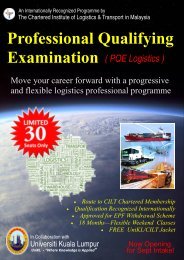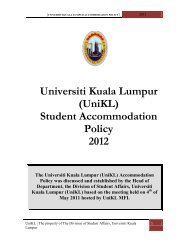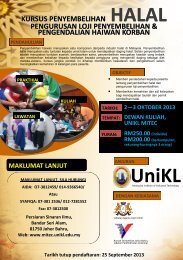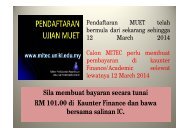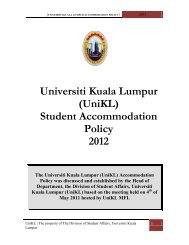Awareness On The Plagiarism 2013 - UniKL | Malaysian Institute Of ...
Awareness On The Plagiarism 2013 - UniKL | Malaysian Institute Of ...
Awareness On The Plagiarism 2013 - UniKL | Malaysian Institute Of ...
- No tags were found...
You also want an ePaper? Increase the reach of your titles
YUMPU automatically turns print PDFs into web optimized ePapers that Google loves.
Organizer : Ms. Latipah Noordin<br />
Teaching & Learning Unit (TLU)<br />
Patron : Dean /HOC<br />
Universiti Kuala Lumpur –<strong>Malaysian</strong> <strong>Institute</strong> of Industrial Technology<br />
(<strong>UniKL</strong>-MITEC)
Overview<br />
Introduction<br />
Definition<br />
Why???<br />
• Factors<br />
Consequences<br />
• Penalty<br />
• Cases<br />
How to avoid?
ARKIB : 28/09/2009<br />
Share on facebook Share on twitter Share on email<br />
Share on print More Sharing Services 8 Plagiat jejas<br />
imej, integriti pendidikan ,Oleh MADZLINA<br />
NORDIN<br />
Artikel Penuh:<br />
http://www.utusan.com.my/utusan/info.asp?y=2009&d<br />
t=0928&pub=Utusan_Malaysia&sec=Rencana&pg=re_0<br />
8.htm#ixzz2Gz3TmsMr \,© Utusan Melayu (M) Bhd
Definition of <strong>Plagiarism</strong><br />
<strong>The</strong> word<br />
“plagiarism”<br />
comes from the<br />
Latin plagiarus<br />
meaning<br />
“kidnapper”
According to the Merriam-Webster <strong>On</strong>line Dictionary (http://www.mw.com),<br />
to plagiarize means:<br />
“transitive senses : to steal and pass off (the ideas or words of another) as<br />
one's own : use (another's production) without crediting the source<br />
intransitive senses : to commit literary theft : present as new and original<br />
an idea or product derived from an existing source”<br />
• In an instructional setting, plagiarism<br />
occurs when a writer deliberately uses<br />
someone else’s language, ideas, or other<br />
original (not common-knowledge) material<br />
without acknowledging its source.(Council<br />
of Writing Program Administrators,<br />
January, 2003)<br />
• Plagiat diklasfikasikan sebagai mencedok<br />
kata, idea dan sebagainya daripada orang<br />
lain dan menggunakannya sebagai karya<br />
sendiri, tiruan atau menciplak. (Kamus<br />
Dewan Edisi Keempat,2005 )
Thousand of Excuses<br />
I’m practicing it before<br />
..in any of my assignment ..<br />
It’s okay if<br />
I don’t get caught!<br />
This assignment<br />
was BORING<br />
Everyone does it!.<br />
.So what ???<br />
I was too busy to<br />
write that paper!<br />
(Job, big game, Face booking !!!)<br />
My parents<br />
expect “A”s!
Thousand of Excuses<br />
“I’m too busy.”<br />
“My work isn’t good enough.”<br />
“I need to cheat in order to have a high<br />
G.P.A.”<br />
“I didn’t know it was plagiarism.”<br />
“<strong>The</strong>y’ll never find out… I’ve done it before”<br />
“I meant to include citations, but I<br />
forgot/ran out of time.”
What’s wrong with<br />
<strong>Plagiarism</strong> ???<br />
<strong>Plagiarism</strong> is one of the academic misconduct. Academic<br />
misconduct is cheating. It is any<br />
action that a student knows (or should know) will lead to the<br />
improper evaluation of academic work.<br />
If the lecturer does<br />
not detect it, academic misconduct defeats the purpose of<br />
academic work because you are pretending to know more or<br />
write better than you actually do.<br />
• 1 st : <strong>Plagiarism</strong> defeat the purpose of University’s goal.<br />
• 2 nd : <strong>Plagiarism</strong> is a form of lying<br />
• 3 rd : <strong>Plagiarism</strong> defeats the purpose of scholarship
Effect of <strong>Plagiarism</strong><br />
• 1 st : <strong>Plagiarism</strong> defeat the purpose of<br />
University’s goal.<br />
When you substitute someone else's understanding or expression for your<br />
own, you avoid the work of using and improving your own expressive<br />
ability. <strong>The</strong>refore, plagiarism defeats the university's goal of teaching<br />
students to write, not just copy.<br />
• 2 nd : <strong>Plagiarism</strong> is a form of lying.<br />
• It is because the lecturer is expecting to read your words, not someone<br />
else's. <strong>Plagiarism</strong> destroys the mutual respect that should exist between<br />
lecturer and student. Many lecturers take plagiarism very personally.<br />
If you have ever taken your time to teach someone something you<br />
consider valuable and then found that your time was wasted, you will<br />
understand the feeling.
<strong>Plagiarism</strong> Effect<br />
• 3 rd : <strong>Plagiarism</strong> defeats the purpose of scholarship.<br />
• Thus it is unacceptable from all scholars, not just students. <strong>The</strong> goal of<br />
scholarship is to discover, understand, and create. That purpose is defeated<br />
when old knowledge is fraudulently presented as original and new. For the<br />
same reason plagiarism is also unacceptable in many non-academic professional<br />
fields such as journalism and creative writing.<br />
• Exceptions in certain fields do not extend to students.<br />
• <strong>The</strong>re are certainly some times in industry and the professions where<br />
originality and authorship are not important and it is appropriate to take<br />
other people's words without citing them. (For example, an engineer /<br />
executive might copy report for a else where without being expected to cite<br />
the source) .<br />
• However, even if you are training for such a profession, you are a student<br />
who is still learning the craft. Whatever the conventions are in the "real world"<br />
of employment in the real world of teaching and learning you are expected to do<br />
your own writing and avoid plagiarism no matter what class you are in.
What are the common<br />
kinds of <strong>Plagiarism</strong> ?<br />
• <strong>The</strong>re are three common kinds of plagiarism:<br />
•<br />
‣Whole-paper plagiarism,<br />
‣Cut-and-paste plagiarism , and<br />
‣Cut-and-paste with references.
What are the common kinds<br />
of <strong>Plagiarism</strong> ?<br />
• Whole-paper plagiarism.<br />
• In this form of plagiarism, all or most of the student's paper is lifted from another student or a<br />
published source, for example the Internet, a book, or a print article. It especially bad to buy a<br />
paper from any source that offers ready-made term papers.<br />
•<br />
• Cut-and-paste plagiarism.<br />
• In this form of plagiarism, parts of a paper ranging from phrases and sentences to entire<br />
paragraphs are taken from the Internet or somewhere else and incorporated into the student's<br />
paper with no signal that they are not the student's own expression.<br />
• Cut-and-paste plagiarism with references.<br />
• In this form of plagiarism, words or ideas in a paper are included from another source, a<br />
reference to the source is included, but there is no quotation signal. Again, the problem is that<br />
a reference indicates only that the accompanying text is somehow derived from or related to<br />
the cited source. A reference alone does not show that the text is a direct quotation from that<br />
source. Thus a reference alone does not suspend the lecturer's expectation that the words are<br />
your own words. A direct quotation with a reference but without quotation marks is<br />
plagiarism.
Consequences
Consequences<br />
• Penalty of Academic Misconduct: Clause 4.1 page 26 in the<br />
University Rules and Regulation Handbook, 7th Edition,2012.<br />
• <strong>The</strong> penalty can be any one or a combination of two or<br />
more of the following penalties ranging from:<br />
• a) reprimanding students in writing;<br />
• b) re-doing of assignment with reduced marks;<br />
• c) Students' work is given 0 marks;<br />
• d) reducing 50% marks for student’s coursework;<br />
• e) Suspension for one semester;<br />
• f) Expulsion from the University
<strong>Plagiarism</strong> …and How to<br />
avoid it !!!<br />
Use these three strategies,<br />
• Quoting<br />
• Paraphrasing<br />
• Summarizing<br />
To blend source materials in with your own.
<strong>Plagiarism</strong> …and How to avoid it !!!<br />
(1) Quoting : To use Proper Citation…<br />
MLA / APA / Harvard<br />
Quotations are the exact words of an author, copied directly from a<br />
source, word for word. Quotations must be cited!<br />
Use quotations when:<br />
• You want to add the power of an author’s words to support your<br />
argument<br />
• You want to disagree with an author’s argument<br />
• You want to highlight particularly eloquent or powerful phrases or<br />
passages<br />
• You are comparing and contrasting specific points of view<br />
• You want to note the important research that precedes your own .
"An effective structure is important" (Redman, 2006, p.22)<br />
Redman, P., 2006. Good essay writing: a social sciences guide. 3rd ed.<br />
London: Open University in assoc. with Sage.<br />
As Frank Lentricchia argues, <strong>The</strong> Waste Land should not be understood as a<br />
logical sequence of events but as “an intellectual and emotional complex<br />
grasped in an instant of time” (194).<br />
In general, when writing for a professional publication, it is good practice to<br />
make reference to other relevant published work. This view has been<br />
supported in the work of Cormack (1994).<br />
Cormack (1994, pp.32-33) states that "when writing for a professional<br />
readership, writers invariably make reference to already published works".
<strong>Plagiarism</strong> …and How to avoid it !!!<br />
(2) Paraphrasing<br />
Paraphrasing means rephrasing the words of an author, putting<br />
his/her thoughts in your own words. When you paraphrase, you<br />
rework the source’s ideas, words, phrases, and sentence structures<br />
with your own. Like quotations, paraphrased material must be<br />
followed with in-text documentation and cited on your Works-<br />
Cited page.<br />
Paraphrase when:<br />
• You plan to use information on your note cards and wish to avoid<br />
plagiarizing<br />
• You want to avoid overusing quotations<br />
• You want to use your own voice to present information
<strong>Plagiarism</strong> …and How to avoid it !!!<br />
(3) Summarizing<br />
• Summarizing involves putting the main idea(s) of one or several<br />
writers into your own words, including only the main point(s).<br />
Summaries are significantly shorter than the original and take a<br />
broad overview of the source material. Again, it is necessary to<br />
attribute summarized ideas to their original sources.<br />
Summarize when:<br />
• You want to establish background or offer an overview of a topic<br />
• You want to describe knowledge (from several sources) about a topic<br />
• You want to determine the main ideas of a single source
IF you are caught<br />
PLAGIARISED, it..<br />
• Shows that you are UNETHICAL person..<br />
•Is cheating , stealing other people ’s<br />
works !!!<br />
• Shows that you're Unprofessional…<br />
•Shows NO Originality in your works !!!<br />
• Shows that your works / ideas have<br />
… NO QUALITY at all !!!
Works Cited<br />
• (1998, March 3). “Boston Columnist Resigns Amid New <strong>Plagiarism</strong> Charges.” CNN.com<br />
19 Aug. Retrieved from http://www.cnn.com<br />
• (2003, May 12). “New York Times Exposes Fraud of own Reporter.” ABC News <strong>On</strong>line.<br />
Retrieved from<br />
• (2012, October 2). Undang-undang beru Jepun hukum pesalah cetak rompak Internet.<br />
Harian Metro <strong>On</strong>line. Retrieved from http://www.hmetro.com.my<br />
http://www.pbs.org/newshour/newshour_index.html<br />
• Anon. (1992, July 31). Kementerian Tubuh Harta Intelek Banteras Kegiatan Cetak<br />
Rompak Utusan Malaysia. Retrieved from<br />
http://www.matzakaria.com/c_penerbitan/inmedia/um92_jul31.jpg<br />
• Brannon, Joyce. (2006, Jan 1). “<strong>Plagiarism</strong>.” PowerPoint Presentation. University of<br />
West Alabama, Livingston, AL. Retrieved from<br />
http://libraryuwa.edu/Help/<strong>Plagiarism</strong>.ppt<br />
• Fain, Margaret. (2003, Feb 12). “Internet Paper Mills.” Kimbal Library. Retrieved from<br />
http://www.coastal.edu/library/mills2.htm<br />
• Lathrop, Ann and Kathleen Foss. (2000). Student Cheating and <strong>Plagiarism</strong> in the<br />
Internet Era. Englewood, CO: Libraries Unlimited.<br />
• Lewis, Mark. (2002, Feb 2). “Doris Kearns Goodwin And <strong>The</strong> Credibility Gap.”<br />
Forbes.com. Retrieved from http://www.forbes.com<br />
• Sabato, Larry J. (2002, March 3). “Joseph Biden's <strong>Plagiarism</strong>; Michael Dukakis's 'Attack<br />
Video' – 1988.” Washington Post <strong>On</strong>line. 1998. Retrieved from<br />
http://www.washingtonpost.com
• Yasin, Khairina. (2009, May 25). Tugasan berunsur plagiat. Berita Harian.<br />
Retrieved from<br />
http://jpt.mohe.gov.my/ARKIB%20dan%20PENERBITAN/keratan%20akhbar/<br />
Mei09/25-05/Berita%20Harian/Mei25-5.pdf<br />
• Valenza, Joyce. (2006, Jan 30). “What is <strong>Plagiarism</strong>?” Springfield Township<br />
High School. Springfield, IL. Retrieved from<br />
http://mciu.org/~spjvweb/plagiarism.ppt
AcMD -MTP : DP1 & DP3 Initiative <strong>2013</strong>
Examination Misconduct RECORD<br />
JUL 2008 – JULY 2011
Examination Misconduct RECORD<br />
JUL 2008 – JULY 2011
AcMD -MTP : DP1 & DP3 Initiative <strong>2013</strong>



